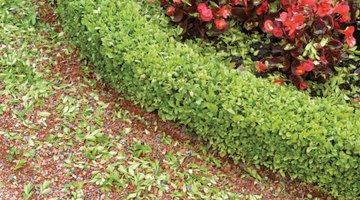Do Boxwood Shrubs Have Big Roots?
The boxwood shrub gets its name from the distinctive shape into which it grows, oftentimes helped by careful gardeners and landscapers. These short shrubs, often no larger than 3 feet tall, are used to mark boundaries, paths and other distinctions in landscapes.

The root system of these shrubs are relatively small, and therefore they require careful maintenance to thrive.
Planting
Caring for the small and shallow root system of a boxwood shrub begins with planting. Most landscapers and gardeners will get one of these shrubs from a garden center or nursery with roots already developed. When you plant it in your landscape, do in a hole that is only just as deep as the root ball itself, and about twice as wide. Insert the plant and fill in the hole, so only a thin layer of soil covers the roots. Planting any deeper than this will prevent the roots from receiving the light, air and water they need to establish in their new homes and result in the plant dying out before it can even get established.
Watering
Watering a shallow-rooted boxwood can make all the difference between a healthy plant and a dying shrub. When you water, do so deeply, so the soil is wet to at least 9 to 12 inches deep. With the water at this deep level, the roots will stretch downward to reach it, helping them get established in the ground. If you give the shrub only surface watering, the roots will remain close to the surface to catch the water and will never become truly established. This can lead to failing shrubs or damage to the roots, which can kill the whole plant.
Mulching
Because the roots of the plant cannot dig in very deeply to the soil, the boxwood is susceptible to problems from the surrounding environment, such as excessive heating or drying out during hot summer days. To help insulate the roots from rapid temperature changes and moisture loss, and also to combat weeds, spread a 2- to 3-inch layer of organic mulch, such as bark, pine needles or wood chips, around the base of the plant, over the roots. The mulch should cover the whole area from the stem of the shrub to at least 1 foot beyond the foliage of the plant. Do not cover the roots with more than 3 inches of mulch, since that will prevent new water from reaching deep into the soil. Remove and refresh the mulch each spring.
Landscape Maintenance
Do not perform any maintenance to the soil within the mulch barrier around the boxwood shrubs. Because the roots are so shallow, they are easily damaged by shovels, hoes, spades, aerators and other lawn tools. Do not dig for weeds; pull any you see by hand and use mulch to cover the rest. Any damage to the roots will lead to infection and potentially the death of the whole shrub.
The Drip Cap
- The boxwood shrub gets its name from the distinctive shape into which it grows, oftentimes helped by careful gardeners and landscapers.
- The root system of these shrubs are relatively small, and therefore they require careful maintenance to thrive.
- Most landscapers and gardeners will get one of these shrubs from a garden center or nursery with roots already developed.
- If you give the shrub only surface watering, the roots will remain close to the surface to catch the water and will never become truly established.
- Remove and refresh the mulch each spring.
References
Writer Bio
Samantha Volz has been involved in journalistic and informative writing for over eight years. She holds a bachelor's degree in English literature from Lycoming College, Williamsport, Pennsylvania, with a minor in European history. In college she was editor-in-chief of the student newspaper and completed a professional internship with the "Williamsport Sun-Gazette," serving as a full-time reporter. She resides in Horsham, Pennsylvania.
Photo Credits
- Medioimages/Photodisc/Photodisc/Getty Images
- Medioimages/Photodisc/Photodisc/Getty Images
More Articles



